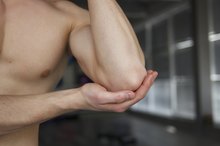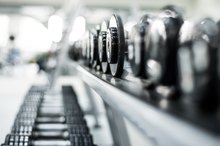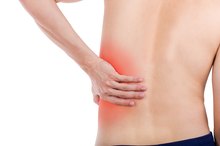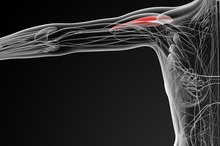What does fact checked mean?
At Healthfully, we strive to deliver objective content that is accurate and up-to-date. Our team periodically reviews articles in order to ensure content quality. The sources cited below consist of evidence from peer-reviewed journals, prominent medical organizations, academic associations, and government data.
The information contained on this site is for informational purposes only, and should not be used as a substitute for the advice of a professional health care provider. Please check with the appropriate physician regarding health questions and concerns. Although we strive to deliver accurate and up-to-date information, no guarantee to that effect is made.
Hurt Left Side of the Lower Back After Leg Pressing
The leg press is actually designed to take pressure off the lower back, but it's still possible to injure yourself while using this piece of muscle-building gym equipment. Any lower-back injury can be debilitating and keep you out of the gym for anywhere from days to months, so don't take lower-back pain lightly. Visit your doctor as soon as that telltale twinge of pain begins.
If you are experiencing serious medical symptoms, seek emergency treatment immediately.
Lower-Back Pain
According to the National Institute of Neurological Disorders and Stroke, nearly everyone experiences lower-back pain at some time in their lives 1. Pain that spreads across your entire lower back can be a sign of a spine injury known as a "herniated disk" or "bulging disk," but if your pain is centralized in the left side of your back, you've likely pulled or torn a muscle or a ligament, which is a band of thick tissue that connects bones to one another. These injuries can occur when you lift -- or in this case, push -- a weight that is too heavy for your body to support. If you've had lingering pain in the area already, it's also possible you have nerve damage or are developing a condition such as arthritis or osteoporosis. Using the leg press may make pain from these conditions worse.
- According to the National Institute of Neurological Disorders and Stroke, nearly everyone experiences lower-back pain at some time in their lives 1.
- Pain that spreads across your entire lower back can be a sign of a spine injury known as a "herniated disk" or "bulging disk," but if your pain is centralized in the left side of your back, you've likely pulled or torn a muscle or a ligament, which is a band of thick tissue that connects bones to one another.
Treating Lower-Back Pain
How to Strengthen the Leg Muscles Damaged by Statins
Learn More
If you have a small, sudden twinge of pain in your left lower back, you likely have a muscle strain. Once your doctor gives you this diagnosis, you can often treat the problem at home. Place ice packs against the area for 20 minutes at a time, three times a day, for the first few days after the injury. You might also take over-the-counter pain relievers to reduce inflammation. In rare cases involving more serious injury -- such as if you've torn a ligament or muscle -- you may need surgery. If your pain is caused by nerve damage or arthritis, your doctor may provide medications that make exercise less painful.
- If you have a small, sudden twinge of pain in your left lower back, you likely have a muscle strain.
- Once your doctor gives you this diagnosis, you can often treat the problem at home.
Strengthening the Lower Back
Certain exercises strengthen your back and prepare your muscles for activity, both of which can reduce your risk of further injuring your lower back. Before you get back into the gym, focus on strengthening your lower back. Try doing exercises that tighten your abdominal muscles; strengthening these muscles gives your back some stability. You might also find that doing squats with your back against a wall or working with an exercise ball improves your lower-back strength. Once you're ready to do leg presses again, spend a few minutes stretching out your back first. Warming up the muscles protects them from strains.
- Certain exercises strengthen your back and prepare your muscles for activity, both of which can reduce your risk of further injuring your lower back.
- Try doing exercises that tighten your abdominal muscles; strengthening these muscles gives your back some stability.
Leg Pressing
Elbow Pain From Working Out
Learn More
Don't climb back onto the leg-press machine until your doctor gives you permission, since returning to physical activity too soon can make your injury worse. Once you've warmed up and are seated at the machine, consider your form. Improper form puts too much stress on your spine and leads to injury. Focus on keeping your lower back pressed flat against the seat of the machine at all times. If you can slip a hand between your lower back and the seat, you're risking injury.
- Don't climb back onto the leg-press machine until your doctor gives you permission, since returning to physical activity too soon can make your injury worse.
Related Articles
References
- National Institute of Neurological Disorders and Stroke: Low Back Pain Fact Sheet
- American Academy of Orthopaedic Surgeons: Low Back Pain Exercise Guide
- "Adult Low Back Pain." Institute for Clinical Systems Improvement (ICSI), (June 1994 rev. Sept. 2006).
- "Lost-worktime Injuries and Illnesses: Characteristics and Resulting Time Away From Work". 2005. Bureau of Labor Statistics.
- "Low Back Pain Fact Sheet". National Institute of Neurological Disorders and Stroke (NINDS).
- Chou R., Deyo R., et. al. Noninvasive Treatments for Low Back Pain. AHRQ Comparative Effectiveness Reviews. Rockville (MD): Agency for Healthcare Research and Quality (US); 2016 Feb.
- Cassidy, J., Cote, P., Carroll, L., & Kristman, V. (2005) "Incidence and Course of Low Back Pain in Episodes in the General Population". Spine, 30(24).
- Deyo, R., & Weinstein, J. (2001). "Low Back Pain". New England Journal of Medicine, 344.
Writer Bio
Henry is a freelance writer and personal trainer living in New York City. You can find out more about him by visiting his website: henryhalse.com.









